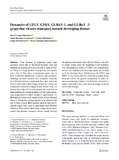Mostrar el registro sencillo del ítem
Dynamics of GFLV, GFkV, GLRaV-1, and GLRaV -3 grapevine viruses transport toward developing tissues
| dc.creator | Crespo Martínez, Sara | es_ES |
| dc.creator | Ramírez Lacunza, Asier | es_ES |
| dc.creator | Miranda Jiménez, Carlos | es_ES |
| dc.creator | Urrestarazu Vidart, Jorge | es_ES |
| dc.creator | Santesteban García, Gonzaga | es_ES |
| dc.date.accessioned | 2023-09-07T16:47:11Z | |
| dc.date.available | 2023-09-07T16:47:11Z | |
| dc.date.issued | 2023 | |
| dc.identifier.citation | Crespo-Martínez, S, Ramírez-Lacunza, A, Miranda, C, Urrestarazu, J, Santesteban, L. G. (2023) Dynamics of GFLV, GFkV, GLRaV-1, and GLRaV -3 grapevine viruses transport toward developing tissues. European Journal of Plant Pathology, 1-9. https://doi.org/10.1007/s10658-023-02703-1. | en |
| dc.identifier.issn | 0929-1873 | |
| dc.identifier.uri | https://hdl.handle.net/2454/46268 | |
| dc.description.abstract | Viral diseases in grapevine cause large economic losses due to decreased irregular yield and unbalanced ripening, and can even lead to plant mortality. There is a large number of grapevine viral agents, and a few of them have a prominent impact due to their worldwide distribution, virulence, and incidence. Although previous research has evaluated variations in viral load between organs and time since infection, there is still a lack of knowledge on how the viruses are transported toward developing tissues. In this work, we present the results of two experiments that contribute to understanding the spread dynamics of four major grapevine viruses (GFLV, GFkV, GLRaV-1, and GLRaV -3). Bud and leaf tissues were sampled from shoots obtained from cv. ‘Garnacha’ cuttings known to be infected with one of these viruses. Bud samples taken at early development stages were used to understand short-distance transport, while leaves taken from young shoots represented long-distance transport, driven mainly through the phloem. Our results show that all viruses were able to invade tissues from the beginning of development. The dissemination ability of GFLV was considerable, as the viral load detected in young organs was as high as in the dormant shoot. Furthermore, for GFLV and GFkV, it was shown that the viral load in young shoots does not follow the general assumption of older tissues accumulating a higher viral load but, conversely, a higher viral load closer to the shoot tip might be driven by the sink strength. | en |
| dc.description.sponsorship | This work was performed in the scope of the BEST-FEET project (Ref.: 0011-1365-2021-000068), with the financial support of co-funded with FEDER funds and regional funds of the Department of Economic Development of the Government of Navarra. Open Access funding provided by Universidad Pública de Navarra. | en |
| dc.format.mimetype | application/pdf | en |
| dc.language.iso | eng | en |
| dc.publisher | Springer | en |
| dc.relation.ispartof | European Journal of Plant Pathology 2023 | en |
| dc.rights | © The Author(s) 2023. This article is licensed under a Creative Commons Attribution 4.0 International License. | en |
| dc.rights.uri | http://creativecommons.org/licenses/by/4.0/ | |
| dc.subject | Grapevine viruses | en |
| dc.subject | Viral load | en |
| dc.subject | Real time RT-PCR | en |
| dc.subject | Phenology | en |
| dc.subject | Buds | en |
| dc.subject | Leaves | en |
| dc.title | Dynamics of GFLV, GFkV, GLRaV-1, and GLRaV -3 grapevine viruses transport toward developing tissues | en |
| dc.type | Artículo / Artikulua | es |
| dc.type | info:eu-repo/semantics/article | en |
| dc.date.updated | 2023-09-07T16:31:18Z | |
| dc.contributor.department | Agronomía, Biotecnología y Alimentación | es_ES |
| dc.contributor.department | Agronomia, Bioteknologia eta Elikadura | eu |
| dc.contributor.department | Institute for Multidisciplinary Research in Applied Biology - IMAB | en |
| dc.rights.accessRights | Acceso abierto / Sarbide irekia | es |
| dc.rights.accessRights | info:eu-repo/semantics/openAccess | en |
| dc.identifier.doi | 10.1007/s10658-023-02703-1 | |
| dc.relation.projectID | info:eu-repo/grantAgreement/Gobierno de Navarra//0011-1365-2021-000068 | en |
| dc.relation.publisherversion | https://doi.org/10.1007/s10658-023-02703-1 | |
| dc.type.version | Versión publicada / Argitaratu den bertsioa | es |
| dc.type.version | info:eu-repo/semantics/publishedVersion | en |
| dc.contributor.funder | Universidad Pública de Navarra / Nafarroako Unibertsitate Publikoa | es |



